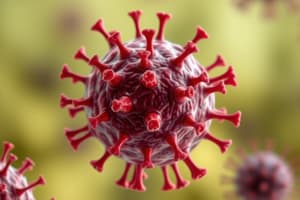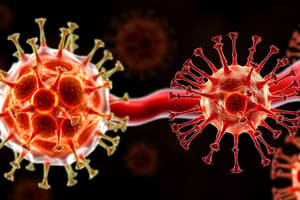Podcast
Questions and Answers
Which of the following cytokines plays a crucial role in T cell proliferation?
Which of the following cytokines plays a crucial role in T cell proliferation?
- TNF-α
- IL-1
- IL-6
- IL-2 (correct)
What type of cells primarily release IFN-α?
What type of cells primarily release IFN-α?
- Dendritic cells (correct)
- Macrophages
- Fibroblasts
- T-helper cells
Which of these cytokines is NOT part of the innate immune response?
Which of these cytokines is NOT part of the innate immune response?
- IFN-γ (correct)
- IL-12
- TNF-α
- IL-6
Which of the following best describes the function of chemokines?
Which of the following best describes the function of chemokines?
Which of these cells is NOT a known source of IL-1?
Which of these cells is NOT a known source of IL-1?
What is the primary role of IFN-β in the immune system?
What is the primary role of IFN-β in the immune system?
Which of the following is NOT a function of IL-1?
Which of the following is NOT a function of IL-1?
Which of the following proteins is NOT a Pattern Recognition Receptor (PRR)?
Which of the following proteins is NOT a Pattern Recognition Receptor (PRR)?
Which of the following is NOT a characteristic of innate immunity?
Which of the following is NOT a characteristic of innate immunity?
Which of the following is a major microbial target of C-reactive protein (CRP)?
Which of the following is a major microbial target of C-reactive protein (CRP)?
Which of the following molecules acts as an opsonin for phagocytosis?
Which of the following molecules acts as an opsonin for phagocytosis?
Which of the following cells is NOT involved in innate cellular immunity?
Which of the following cells is NOT involved in innate cellular immunity?
How do PRRs (Pattern Recognition Receptors) activate phagocytosis?
How do PRRs (Pattern Recognition Receptors) activate phagocytosis?
What is the role of soluble CD14 in innate immunity?
What is the role of soluble CD14 in innate immunity?
Which of the following is a characteristic of adaptive immunity?
Which of the following is a characteristic of adaptive immunity?
Flashcards
Innate Immunity
Innate Immunity
Inborn resistance present at the first pathogen encounter, not modified by repeated exposure.
Acquired Immunity
Acquired Immunity
Resistance that weakens initially and strengthens with later exposures to the same pathogen.
Phagocytosis
Phagocytosis
The process where cells engulf and digest pathogens.
Opsonization
Opsonization
Signup and view all the flashcards
Complement C3b
Complement C3b
Signup and view all the flashcards
Cytokines
Cytokines
Signup and view all the flashcards
Pattern Recognition Receptors (PRRs)
Pattern Recognition Receptors (PRRs)
Signup and view all the flashcards
PAMPs
PAMPs
Signup and view all the flashcards
APC Function
APC Function
Signup and view all the flashcards
Functions of Interleukins
Functions of Interleukins
Signup and view all the flashcards
Neutrophils
Neutrophils
Signup and view all the flashcards
Interferons Function
Interferons Function
Signup and view all the flashcards
Type I Interferons
Type I Interferons
Signup and view all the flashcards
IL-2
IL-2
Signup and view all the flashcards
Study Notes
Innate and Adaptive Immunity
- Innate immunity is the body's inborn resistance to pathogens encountered for the first time. It doesn't require prior exposure and isn't significantly altered by repeated exposure.
- Acquired immunity is a resistance that's initially weak or absent at first exposure. It dramatically strengthens with subsequent exposures to the same pathogen.
Components of Innate Immunity
- Barriers to infection: Provide the initial line of defense.
- Innate Cellular Response: This response is dependent on cellular activity:
- Innate Phagocytic Cellular Activity:
- Antigen-presenting cells (APCs) like monocytes and macrophages. These cells present antigens to T-helper cells, initiating an immune response.
- Killer cells like neutrophils and eosinophils. These cells directly attack and destroy pathogens. Phagocytosis is activated by soluble proteins (innate response).
- Innate Phagocytic Cellular Activity:
- Innate Soluble Mediators: These are proteins that mediate the immune response:
- Cytokines: Soluble proteins produced by immune and non-immune cells. Examples: IL-1, IL-12, IFN-α, IFN-β.
- Acute-phase proteins (humoral response): These proteins play a crucial role in the body's response to infection.
- Complement C3b: Part of the complement system, involved in the alternative complement pathways.
- Inflammation Process: Part of the overall innate immune response.
Innate Soluble Mediators - Plasma Proteins
-
Various plasma proteins act as pattern recognition receptors (PRRs) and acute-phase proteins. These proteins interact with microbes non-specifically, triggering phagocytosis.
- Soluble plasma proteins:
- C-reactive protein (CRP): Recognizes polysaccharides of microbes and opsonizes them.
- Mannose-binding proteins: Recognizes high-mannan glycoproteins and opsonizes them and activates complement.
- Soluble CD14: Recognizes bacterial lipopolysaccharide (LPS), opsonizing them.
- Complement C3b: Tags polysaccharides on bacteria and activates the alternative complement pathway.
- Soluble plasma proteins:
Opsonization and Phagocytosis
- Opsonization: The process where immune cells tag pathogens with proteins to enhance phagocytosis.
- Phagocytosis: The ingestion and destruction of pathogens by phagocytic cells. The complement system is crucial to this process.
Cellular Activity of Innate Response
- Activated antigen-presenting cells (APCs) stimulate T-helper lymphocytes:
- In bloodstream, APCs like monocytes.
- In body organs/lymph nodes, APCs like macrophages and dendritic cells (DCs).
- Killing of infectious agents:
- Neutrophils kill bacteria.
- Eosinophils kill parasites.
- Mechanism of inflammation: Processes mediating the immune response to infection and injury.
Components of Adaptive Immunity
- Adaptive Immune Cells:
- Memory T-helper cells activity.
- Memory T-cytotoxic cell activity.
- Memory B-lymphocyte activity.
- Adaptive Soluble Mediators:
- Cytokines produced by helper and B cells.
- Complement components of the classical pathway.
- Soluble and cell-bound proteins: Antibodies (immunoglobulins).
Cytokines
- Cytokines are low-molecular weight, soluble proteins produced by immune and non-immune cells. They act as signaling molecules between cells.
- Lymphocyte-produced cytokines are called lymphokines.
- Cytokines that attract cells to sites of inflammation are chemokines.
- Cytokines that interfere with viral replication are interferons.
- Cytokine types include: interleukins, interferons, lymphokines, and chemokines.
Functions of Interleukins and Interferons
- Interleukins:
- Regulate cellular interaction and induce an inflammatory response of the innate and adaptive immune system.
- Regulate cellular growth and differentiation.
- Interferons:
- Produced by virally infected cells.
- Protect neighboring cells from viral infection.
- Activate phagocytosis and apoptosis of infected cells.
- Involved in antiviral and antitumor immunity.
Cytokines of Innate and Adaptive Immunity
- Innate immunity cytokines: IL-1, IL-6, IL-12, TNF-α (produced by activated phagocytes), IFN-α (dendritic cells), IFN-β (fibroblasts)
- Adaptive immunity cytokines: IL-2, IL-4, IL-5, IL-10, IL-13, IFN-γ (type 2 IFN).
Cytokine Functions
- Provided in a table format, including cytokine, cellular source, targets, and function.
Cytokines and Immune Cells Interaction
- Describes the interactions between immune cells and cytokines in the context of an immune response to a pathogen.
Interferons (IFN)
- IFN-α: Produced by lymphocytes, epithelial cells, and fibroblasts. Targets a wide range of cells. Functions: up-regulates MHC class I, inhibits viral proliferation.
- IFN-β: Produced by epithelial cells and fibroblasts. Targets a wide variety of cells. Functions: up-regulates MHC class I, inhibits viral proliferation.
- IFN-γ: Produced by CD8, CD4, and NK cells. Targets T, B, NK, and endothelial cells. Functions: antiviral, antiparasitic, enhances MHC class I and II expression.
Studying That Suits You
Use AI to generate personalized quizzes and flashcards to suit your learning preferences.




